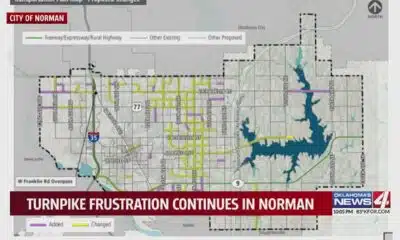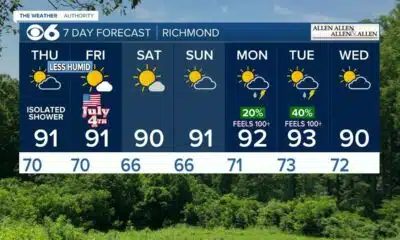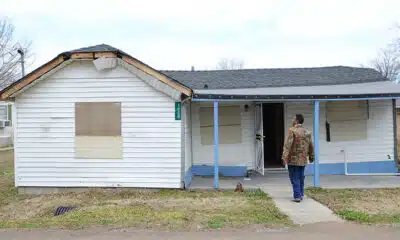News from the South - South Carolina News Feed
Autism Awareness Month – helping those with the diagnosis feel seen, heard, and loved
SUMMARY: April is Autism Awareness and Acceptance Month, aiming to support those with autism. The annual “Autism Connect” event in Columbia, attended by over 800 people, highlighted the challenges faced by individuals with intellectual disabilities in employment and independence. With one in 36 children and one in 45 adults living with autism, symptoms can vary widely. Signs may include sensory sensitivities and social difficulties, but individuals often possess unique strengths, such as attention to detail. The Unum Center for Neurodevelopment also marked the occasion by dyeing the Five Points fountain blue, promoting understanding and compassion for the autism community.
The post Autism Awareness Month – helping those with the diagnosis feel seen, heard, and loved appeared first on www.abccolumbia.com
News from the South - South Carolina News Feed
Once known as ‘Dirty Myrtle,’ Myrtle Beach is now the fastest-growing US metro for seniors
SUMMARY: A South Carolina beach town once known as “Dirty Myrtle” for its rowdy nightlife has transformed into the fastest-growing U.S. metro area for senior citizens. Myrtle Beach’s population aged 65 and older grew by 6.3% last year and over 22% during the 2020s, now making up more than a quarter of its 413,000 residents. The pandemic encouraged retirees and remote workers from states like Ohio and New York to settle there, attracted by the climate, low taxes, and recreational opportunities. Nationwide, the senior population rose 3.1% last year, while the child population declined, reflecting an aging U.S. demographic.
The post Once known as ‘Dirty Myrtle,’ Myrtle Beach is now the fastest-growing US metro for seniors appeared first on www.abccolumbia.com
News from the South - North Carolina News Feed
Population loss in Western NC after Helene expected
In the aftermath of Tropical Storm Helene, some in government and the news media were sounding the alarm on the prospect of population loss in affected areas of the state. The fear that there would be a mass exodus from the North Carolina mountains was contagious.
The storm’s effect on the population will likely not be as dramatic as some imagined, but that doesn’t mean nothing has changed. It’s hard to say, nine months out, what to expect as the situation continues to develop.
But some clues have come into focus.
[Subscribe for FREE to Carolina Public Press’ alerts and weekend roundup newsletters]
State demographer Mike Cline thinks that, in the best-case scenario, the region will lose about 5% of its displaced population. The worst-case scenario could result in population loss as high as 35% among those who have been displaced.
Two factors affecting population were already in play. Families were being priced out of Western North Carolina — and the population has been aging.
Then came Helene. Some lost their homes and were forced to leave. They often had no choice. Some evacuated and never came back. People lost loved ones, pets, cars, businesses and so much more that had tied them to the area.
While most people who left their community will take up residence somewhere else in Western North Carolina, according to Cline, some won’t. Those who do return are likely to be older and have more financial resources than those who do not.
On the other hand, many, many people have stayed put and appear likely to remain where they are.
“When you have a disaster, people want to know immediately what is happening,” Cline told Carolina Public Press. “Most studies show that 65% to 95% of people, depending on the disaster, will return within six months to a year.
“But the data is limited. Most of Western North Carolina’s population live in unincorporated communities or very small towns. When you have a smaller population, it’s harder to track.”
But that doesn’t stop him from trying.
His office formed an ad-hoc subcommittee to meet and discuss the issue of population change post-Helene. They look at housing permits, demolition rates, rehabilitated properties, school enrollments and surveys of local governments.
From there, they can start to get a sense of how many people were displaced and unlikely to return. But they are wary to release anything official until more robust data is available.
Changing population migration patterns
The storm may deter or delay people who were thinking of moving or retiring to Western North Carolina.
“Are the people who were planning to move here actually going to move now?” Cline asked. “That’s where I think the greatest impact in terms of future growth or change will be.”
The region was seen as something of a “climate haven” before Helene, a place where one could be safe from extreme temperatures, sea-level rise and natural disasters, according to Mitchell County resident Lori Gilcrist.
The mountains have lost that status, she says. The chance of something like Helene happening again may decrease the region’s popularity.
It also could be the final straw for someone who was thinking of leaving the region already.
But Gilcrist, for one, said she is not going anywhere.
One factor Cline talks about is the “rootedness” of the region. Even though it’s a popular retirement destination, some families have been there for generations, folks born and raised and still living in the same communities their great-grandparents did.
That Appalachian rootedness may insulate the region from extreme population loss.
Academic aftershocks
But for some populations, like the student population at Appalachian State University in Boone, for example, that rootedness is not really a factor.
“There were a lot of students who had housing problems and real psychological trauma, during and right after the event,” said Colin Kelley, a professor of climate science at App State. “Many had to go home to help their families or deal with their own problems.”
In the Henderson County school system, enrollment dropped by 283 students after the storm.
That number includes families who left the region completely, relocated to a different school district or withdrew their children from school while dealing with the aftermath.
In Buncombe County, eight schools experienced “large losses” in the student body, meaning losses of 20 students or more.
But school officials in Haywood and McDowell County say enrollment numbers have been steadily declining for years, so it’s hard to say how different things would have looked if Helene had not happened.
That’s the prevailing feeling in the Haywood County government as well.
“It’s really difficult to quantify population changes and even more so to attribute any shifts directly to Helene,” said Dillon Huffman, the public information officer for Haywood County.
“From a local government perspective, I don’t know how we associate anything as a direct result of the storm. In fact, I would venture to say that Haywood County has grown in terms of overall population over the past year. One indicator we keep an eye on is building permit activity, which remains strong.
“We won’t have official Census data for another five years, and we’re only nine months out from Helene — it’s tough to establish meaningful trends in such a short window.”
Clarification: This article has been updated to show that the predicted 5% to 35% population loss for Western North Carolina is among just the displaced portion of the population and not the overall population. An earlier version of the article was unclear on that point.
This article first appeared on Carolina Public Press and is republished here under a Creative Commons Attribution-NoDerivatives 4.0 International License.
The post Population loss in Western NC after Helene expected appeared first on carolinapublicpress.org
Note: The following A.I. based commentary is not part of the original article, reproduced above, but is offered in the hopes that it will promote greater media literacy and critical thinking, by making any potential bias more visible to the reader –Staff Editor.
Political Bias Rating: Centrist
This article provides a factual and balanced report on the population impacts following Tropical Storm Helene in Western North Carolina. It relies on data from multiple sources, including state demographers, local officials, and academics, presenting varying perspectives without editorializing or advocating for a specific political viewpoint. The language is neutral, focusing on observed effects and uncertainties without emotional or ideological framing. There is no clear alignment with partisan or ideological stances, reflecting an objective, data-driven approach typical of centrist reporting.
News from the South - South Carolina News Feed
Myrtle Beach Police amp up security, extend youth curfew ahead of July 4th
SUMMARY: Myrtle Beach police are increasing security and extending a youth curfew ahead of the busy July 4th weekend following a deadly shooting on Ocean Boulevard. City and police officials expect large crowds on the Grand Strand and have implemented safety measures citywide. Every officer will work split shifts, supported by 1,200 monitored cameras providing real-time crime data. Since April, multiple shootings—including one fatal—have occurred, some involving juveniles. As a result, a temporary curfew for those 17 and under runs from 10 p.m. to dawn through July 7, covering key areas of the city. Enforcement begins early afternoon to inform the public.
Starting tomorrow, Myrtle Beach will implement a stricter curfew for minors following a series of recent shootings in the Grand Strand, including a deadly incident on Ocean Boulevard last Friday.
The new curfew, which affects those aged 17 and under, will begin at 10 p.m. and remain in effect until July 7.
This comes at the same time Myrtle Beach Police are making sure security measures are in place ahead of the Fourth of July weekend.
“We look ahead and we use our prior experiences with year after year of our larger weekends especially Fourth of July and we go on what works for us and then from prior weekends we see what improvements we can make,” Captain Paul Morrell of the Myrtle Beach Police Department said.
Read more: https://bit.ly/3GvDQ6W
Stay up to date with our social media:
WPDE on Facebook: / wpdeabc15
WPDE on Twitter: / wpdeabc15
Subscribe to WPDE on YouTube: / @wpdeabc15
For more information, visit https://wpde.com/
Have a news tip? Send it directly to us:
Email us: abc15news@wpde.com
Call the Newsroom: 843.487.3001
WPDE is a SC based station and an ABC Television affiliate owned and operated by Sinclair Broadcast Group. WWMB is a SC based station and a CW Television affiliate owned and operated by Howard Stirk Holdings and receives certain services from an affiliation of Sinclair Broadcast Group.
#WPDE #ABC15News #ABC15 #WPDE15 #MyrtleBeach
-
Mississippi Today6 days ago
Defendant in auditor’s ‘second largest’ embezzlement case in history goes free
-
News from the South - Georgia News Feed5 days ago
Are you addicted to ‘fridge cigarettes’? Here’s what the Gen Z term means
-
The Conversation6 days ago
Toxic algae blooms are lasting longer than before in Lake Erie − why that’s a worry for people and pets
-
News from the South - Tennessee News Feed6 days ago
5 teen boys caught on video using two stolen cars during crash-and-grab at Memphis gas station
-
Local News6 days ago
St. Martin trio becomes the first females in Mississippi to sign Flag Football Scholarships
-
Local News7 days ago
Mississippi Power shares resources and tips for lowering energy bill in the summer
-
News from the South - Kentucky News Feed7 days ago
Error that caused Medicaid denials has been corrected, says cabinet in response to auditor letter
-
News from the South - Georgia News Feed7 days ago
GOP mega-bill stuck in US Senate as disputes grow over hospitals and more










































